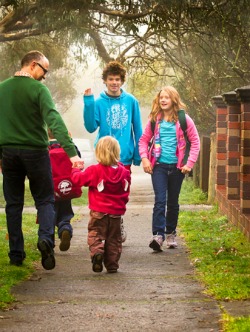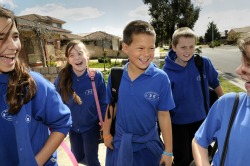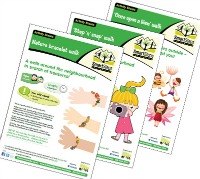Programs for children
Key messages

VicHealth has commissioned research on Active Transport, Children and Young People, which found:
- Parental concern is the main barrier to children's participation in active travel, so parental involvement in behaviour change is crucial.
- Children are known to enjoy walking and cycling in their neighbourhoods, and prefer to walk or cycle to school.
- Parents and children are most open to 'social cues' about active travel when they move to new environments and engage with new organisations. The transitions therefore from kindergarten to primary school, and primary school to secondary school are opportune times to influence behaviour change.
Parental chauffeurs: what drives their transport choice? identified:
- For parents who drive their children to school, fear of their child being hit by a car and lack of trust in the local neighbourhood are their main reasons.
- Most parents report having greater freedom to walk during their childhood, compared with their own children.
- Some parents report that they have more informative conversations with their children while walking.
Primary school
The National Institute of Health and Clinical Excellence (2012) suggests:
 Schools should establish a culture that supports walking and cycling for journeys both to school and during the school day, for all staff, parents and students.
Schools should establish a culture that supports walking and cycling for journeys both to school and during the school day, for all staff, parents and students.- It can be advantageous for a school to identify a walking champion (or champions) with sufficient senior support to coordinate activities to increase walking.
- It is important that schools develop parents' and carers' awareness of the benefits of walking and other modes of active travel. See our benefits for children page for information on the important for children of walking to school and as part of their everyday life.
Active Travel, Children and Young People reported:
- When engaging with schools, it is important to understand their motivations for promoting active travel; many see active travel as important for promoting health and environmental sustainability, while others may be more interested in opportunity for traffic management, or facility provision.
- Changes have been achieved, at least in the short‐term, through programs such as Safe Routes to School, Walking School Buses, School Travel Planning, and Walk/Ride to School events. These initiatives however need to be complemented by area-wide improvements in infrastructure that support children to walk and cycle within their neighbourhood.
The British publication Children: Practical strategies for promoting physical activity provides advice on program design targeting 6-11 year olds.
Resources for Victorian teachers to cultivate an active classroom, and help students become more active by walking are available Smart Steps for Primary Schools.
Secondary school / young people

UK research suggests that lack of time, having a lot to carry, and wearing inappropriate footwear are given as the main barriers to walking for travel or leisure for young people (National Institute of Health and Clinical Excellence 2012).
Encouraging young people to delay purchasing their first car when they move from school to post‐school education, may help young people choose more economical transport at a time of lower income.
Teach students about walkability and liveabilty through Year 7, 9 and VCAL projects developed in partnership with Geography Teachers of Victoria - Smart Steps for Secondary Schools.
Families
Parents are pressed for time and encouraging them to walk with their children can be challenging. Find resources, tips and how to guides to support children to walk more:
- Tips and ideas (including walk together to school, fun family activites)
Councils can use these resources to support their own programs to promote walking.
Resources and programs
- Travel planning - school travel planning involves developing and implementing travel plans for students to encourage their use of active travel modes. Travel plans can be integrated with those produced by other local schools and community groups. Students should be involved as much as possible in the travel planning process, and performance targets set.
- Streets Ahead Evaluation Report, VicHealth - learnings and case studies from the Streets Ahead Program, whereby six councils were funded to create supportive environments that increase children's active travel and independent mobility in all aspects of their local community life, not only to and from school.
- Playborhoods - a community initiative which councils can facilitate.
Examples
Cardinia Shire Council's Streets Ahead programme takes a broader approach than traditional walk to school programs, with innovative components like skateboard lessons and installation of skateboard and scooter storage units. Their 'stop and drop' program identifies safe routes to school and encourages parents to drop their children on those routes and walk the rest of the way to school. Informal surveys found that active travel to participating schools increased from 35% in 2009 to 53% in 2011. Further case studies are provided via the links below.
